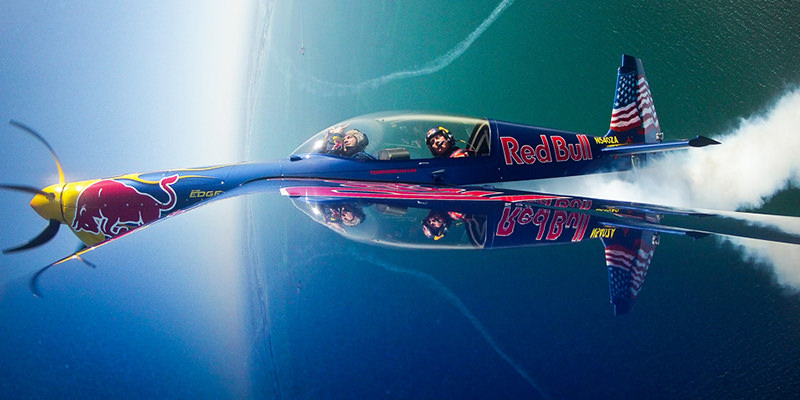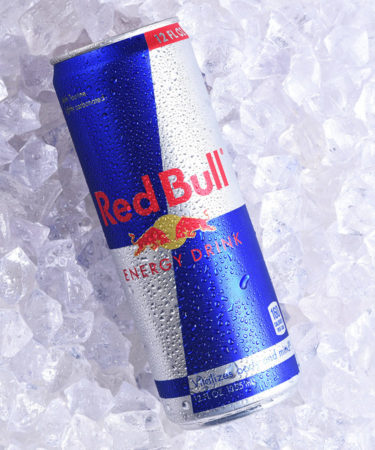You’re groggy, underpaid, shopping for some digestible energy, and you pass a case full of “Trucker Pills”—rows of neatly packaged amphetamines with names like “No Doze” and “Exxxtreme Alert.” You wouldn’t buy them, right? Probably wouldn’t grab a bottle, head back to your desk, and take one (or two) for the long night ahead? What if they were in a Red Bull can?
Turns out everyone’s favorite cough syrup-colored energy elixir has origins in slightly shady circumstances. The late Chaleo Yoovidhya was a Thai billionaire, and founder of TC Pharmaceuticals. One of his products—and a boon for his eventual billions—was a “tonic” that was originally developed to keep factory workers and truckers awake, and productive, presumably for incredibly long shifts. Called “Krating Daeng,” basically Thai for “Red Bull,” the drink contained sugar, water, caffeine, everyone’s favorite taurine, inositol (an anxiolytic), and some B vitamins. Red Bull wasn’t developed to give Millenials wings so much as keep Thai citizens working.
So how did we get from a tonic for trucker wakefulness to the youth-oriented, cough syrup-hued extreme-sports fuel and beloved vodka mixer that gleams in refrigerated cases all over the world? The answer, as usual, is marketing. Austrian entrepreneur Dietrich Mateschitz stumbled upon Krating Daeng in his travels and took the brand global by 1997—at which point he was less interested in the “worker productivity” angle and more interested in exploiting every possible marketing euphemism that could be milked from the teat of “energy” (just think of that manipulative speech your boss gives you before he or she asks you to stay late, give 110%, be a team player, skip lunch).
Red Bull never sold a product. They still don’t. They sell an image, with lifestyle-oriented branding and social media input, and just casually make the product part of that image (to the tune a brand value of $7.2 billion dollars and 40 million Facebook fans). It’s kind of like when an adult tries to find a “cool” way to relate to their newly, terrifyingly hormonal teenage kid: the clueless dad might strut into the room, turn a chair backwards, sit down, and ask to “rap about what the haps are.” Red Bull is like the dad who lets you have a sip of his local craft beer and then says, “If you can’t find a way to be real with me, bud, no base jumping this weekend. Your call.” (And then rocks out on his guitar.)
In early days, Red Bull even took it to the streets with youth “guerilla marketing” teams. (If you’ve ever seen Role Models, just think of Sean William Scott exhorting junior high schoolers to “Taste the beast!” Basically that, but less hilarious.) Associations with extreme sports helped boost credibility: indie athletes, looking for adrenaline, keeping themselves “amped up” with Red Bull, snowboarding and hang gliding and probably—we hope—doing Parkour. Bigger alliances, with NASCAR and famous athletes and even the eventual purchase of a couple soccer teams, kept Red Bull’s energy promises squarely (and more innocently) in the bad ass “achievement” realm. Add some fully legit charitable initiatives, and a dash of Recession-era job market to pressure indebted Millenials into accepting the false promise of “work-life balance,” and a slim can of energy (plus vitamins!) seems like a boon. A blessing. A bro hug in a can.

Ah, and then of course there’s the alcoholic angle—one that Red Bull doesn’t actively promote, or deny. Red Bull and Vodka has been on the late night drinks scene in the U.S. since the early 2000s, even before Four Loko stumbled, a bit more honestly, into the mess. The basic idea is the caffeine in Red Bull will keep you going despite the intake of alcohol—meaning you can rock out to the Red Bull-collaboratead Skrillex “Mothership Tour” as long as you want. Truth is, the caffeine (each can contains 80 milligrams, about as much as a cup of coffee) will probably keep you from noticing if you’re too drunk, or even impaired, and too much caffeine has already been proven to aggravate heart conditions, cause heart palpitations, basically bang on your heart’s walls like a neighbor complaining about all the Skrillex you’re playing.
Question is, why is Red Bull still so dominant? It’s a question we can’t quite answer, likely because we’re all too busy trying to live the lifestyle that Red Bull sells (not necessarily base jumping, which I plan on Googling later, but being productive, achieving, and then “rewarding” myself with some irresponsible partying). Red Bull’s official site says it’s for anyone: “On the road, during lectures and study sessions, at work, while doing sports, playing video games, or going out day and night.” Energy, to keep you going, whether you like it or not.
